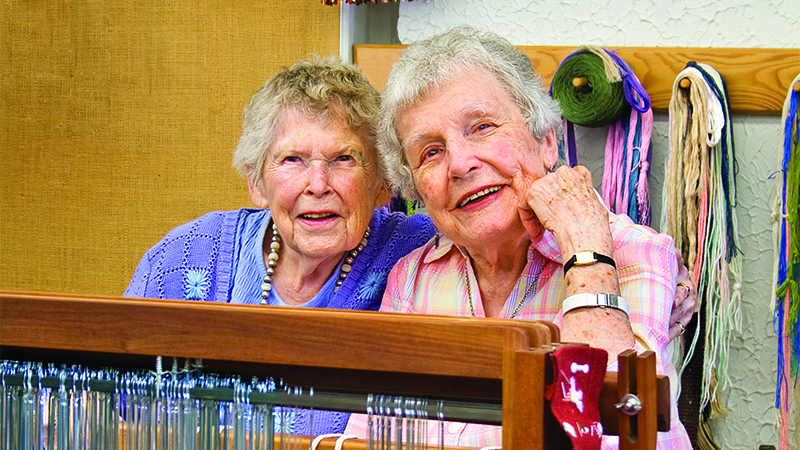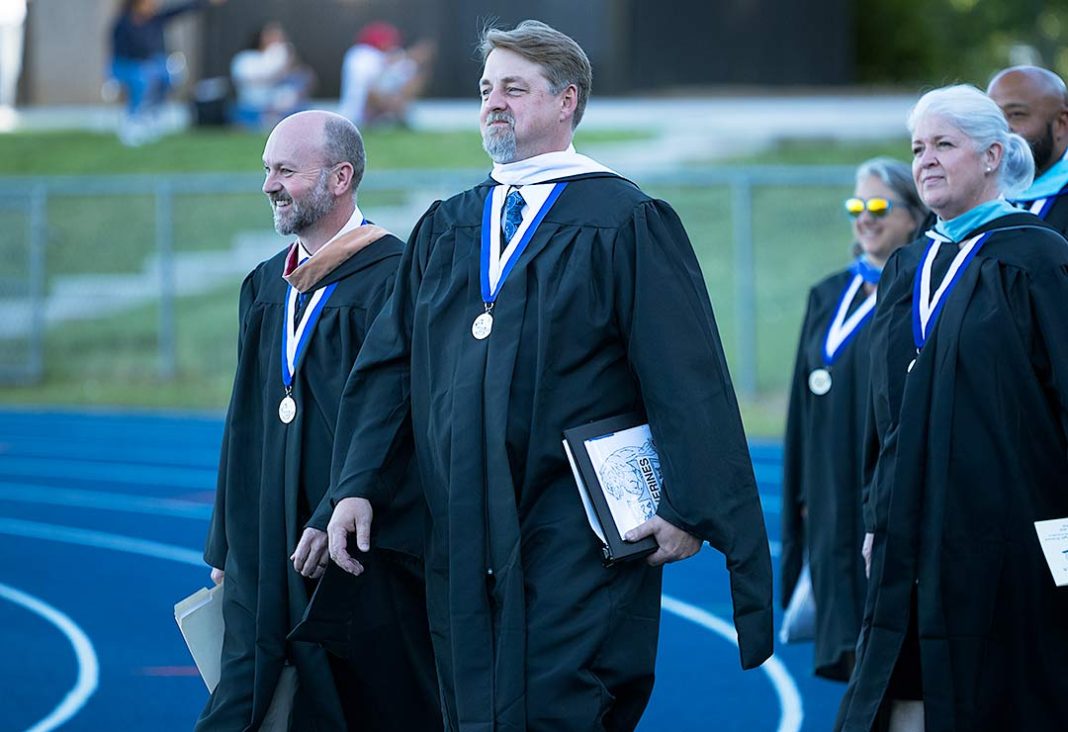Warp and Weft of the Grand Weavers of TACS
Published 2:14 pm Monday, October 2, 2017

- At 99 years old, Barbara Haythorn and Agnes Sternberg each recall fondly the click-clack of the looms as their students over 26 years set the rhythm for the shuttle and shed of weaving at Tryon Arts and Crafts School.
At 99 years old, they each recall fondly the click-clack of looms as their students set the rhythm for the shuttle and shed of weaving. Year after year, uncounted yards inched forth with the beat, crafting patterns and textures thread by thread. For 26 of their 99 years, Barbara Haythorn and Agnes Sternberg taught together the art and craft of transforming yarn into fabric. With so much of their lives woven together in preserving an ancient skill for Tryon, they are the warp and weft of the very fabric of the Tryon Arts and Crafts School (TACS).
Their smiles warmed when I asked them to explain the basic “how to” of weaving. As a child I had fallen asleep five nights a week to the railcar roar of carpet looms in the Philadelphia mill across the street where my father worked as a weaver. When handing off his lunch bag at the foot of his giant mystery machine, I vaguely remember looking up at a wall of vibrating threads. But not until this day, with these two eager teachers, did I begin to understand and appreciate what he had been doing.
Warp and weft are the essentials of weaving unchanged for at least 8,000 years. Most likely, an unheralded genius of Mesopotamia first aligned vertical strands of fiber side by side and then threaded horizontal fibers through them at 90 degrees, one by one, over and under, over and under. Sometime before the 12th century, the vertical fibers came to be called warp based on the Old English wearp, “to throw.” The horizontal became woof or weft based on the Old English wefan, “to weave.” By then, looms of one type or another had been at work for millennia.
Agnes and Barbara volleyed names back and forth—handloom, Inkle loom, warp weighted loom, back strap loom, and others, including power looms. The ancient warp and weft principle was the same for all, even with the powered Jacquard loom my father had probably used with complex fabric designs stored in punch cards.
And that noise I so clearly remember? Why so loud? They knew.
Flying shuttles, one of many moving and banging parts, contributed to the decibels. Slamming back and forth across the carpet width, the wood canoe-like shuttle carried a bobbin of yarn that trailed out as the weft through the shed of warp.
“Bobbin, shed?”
Barbara and Agnes seemed pleased with my questions as I scribbled answers and pledged to do further research. I learned, for example, that with some manual looms, foot pedals raise and lower different levels of warp. Shed is the transitory opening between levels through which a hand-flicked shuttle passes with the weft.
Wondering about the origins of their knowledge, I asked Barbara, “Did you start weaving as a girl?”
“As a child in Iowa, I had rickets and a cast from hips to toes…did a lot of things with my hands. I liked decoupage, making beautiful things. But it wasn’t until 1965, when my son left for college, that I started weaving as a way to create beauty. I wanted to learn from Ruth Myers.”
Ruth Myers, active in the Handweavers Guild of America, was a prominent weaver/teacher in Chicago with classes in her home full of looms.
Agnes, born in rural Saskatchewan, recalls being 40-something, living in Chicago when she saw weaver/inventor Elphege Nadeau on TV. She had read about his invention of a portable aluminum loom. She wrote to him in Woonsocket, R.I., asking if he knew anyone to teach weaving in the Chicago area. He replied, Ruth Myers.
So, Agnes and Barbara met.
Click-clack. Warp and weft.
Weaving brought them together and would keep them together.
“I had an uncle in Tryon and remember coming on family vacations for his horses and weather,” says Agnes. “My husband and I retired here in 1978…I looked for handweavers and joined Tryon Crafts working in the basement of the Tryon Fine Arts Center…basically a supply closet for the painters upstairs.”
Barbara remembers, “My husband and I visited former neighbors who had moved to Tryon. We liked it here so much, we bought a lot in 1973.” When her husband retired in 1978, they moved, and until their home was ready, stayed with Agnes and her husband.
Barbara and Agnes were teaching in 1986 when Barbara’s husband, Building and Grounds Chair on the Tryon Fine Arts Center board, helped arrange the purchase of what would be the Cate-Hall Weaving Cottage. Agnes recalls a class at the cottage, about 20 years later, when one of their students, Jeanette White, left early to keep an appointment with a lawyer. In appreciation of the camaraderie of weavers and the joy of learning, Jeanette was finalizing the paperwork that would leave enough money for Tryon Arts and Crafts to acquire the Tryon Middle School as its new home at 373 Harmon Field Road. Agnes remembers the truck moving 16 looms from the cottage. “Twelve are still here,” she says, gesturing over the 20 or so looms in the classroom.
Now retired from teaching, both reflect with satisfaction on what weaving meant in their lives.
For Barbara, weaving was “soothing.” Focusing on a particularly complicated pattern took her into her own relaxing world. “I loved creating my own patterns and the pride I felt in a finished scarf or jacket, but my fondest memories are teaching on Tuesdays. I’d plan all week for class day and loved the people who were learning, sharing, having a good time. My hope is that it continues.”
Agnes liked to make gifts and hear such exclamations as “You made this pillow!?” There was also pleasure seeing her students take pride in what they created. “Through weaving I’ve made so many friends. Wonderful that there are five of us long-time weavers from the school retired at White Oak. Barbara and I are also fortunate to have students willing to carry on as teachers. We asked Suzanne [Monroe] in about 2010.”
Another former student, Kris Schweikardt, was teaching while I was photographing. As she advised a first time student, I could not help but notice the difference between the teacher’s gray hair and lines of experience, and the student’s black hair and youthful complexion. But both were equally taken in by the warp and weft.
Click-clack.
Agnes and Barbara should be pleased to know that a new generation has arrived. •
A photo waits in all things, all places, and everyone with a passion has a story to be told. That’s the perspective Vince Verrecchio, lightly retired ad agency creative director, brings as a writer and photographer contributing to Foothills Magazine. He can be reached at vincent.verrecchio@gmail.com.





